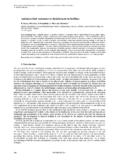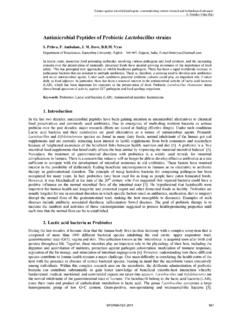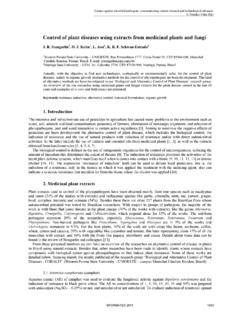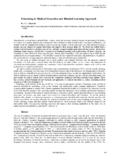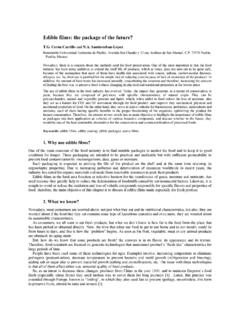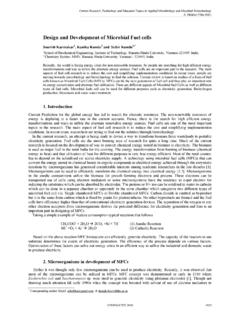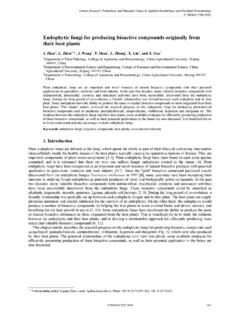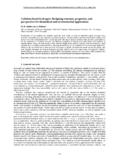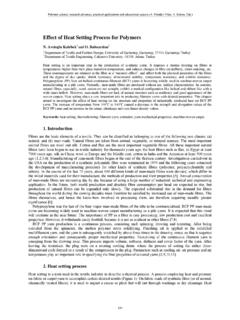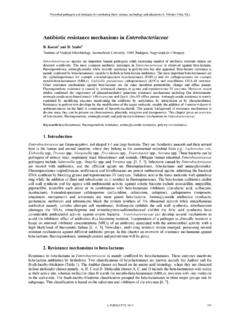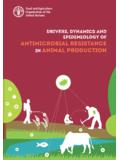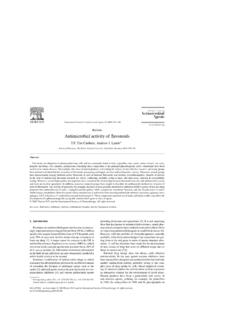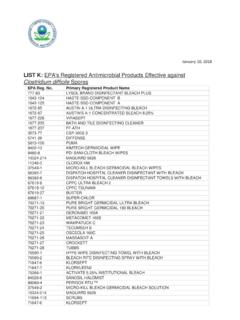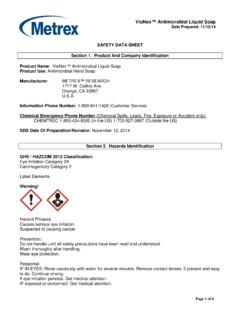Transcription of Antimicrobial compounds produced by Bacillus spp. and ...
1 Science against microbial pathogens: communicating current research and technological advances _____. A. M ndez-Vilas (Ed.). Antimicrobial compounds produced by Bacillus spp. and applications in food F. Baruzzi, L. Quintieri, M. Morea and L. Caputo1. 1. ISPA-CNR, Institute of Sciences of Food Production, National Research Council of Italy, Via G. Amendola 122/o, 70126, Bari, Italy The Bacillus genus is a heterogeneous group of Gram-positive, facultative anaerobic, endospore-forming bacteria spread into the environment, even though soil is generally accepted as its natural reservoir. The ability to produce endospores allows Bacillus to withstand extreme environmental conditions as those occurring in food processing.
2 Bacillus spp., particularly B. subtilis, are usually found in foods such as dry cured sausages, cheeses, traditional fermented milks, sourdough, etc. in which they cooperate with other microorganisms during fermentation, releasing amylases, lipases and proteases. One of the main characteristics shared among Bacillus strains is the ability to produce a wide range of Antimicrobial compounds active against bacteria and fungi. Even though microbial control exerted by these metabolites was demonstrated in plant environments, few reports focused their attention on how these compounds can interact with food microbiota. One single Bacillus strain is often able to produce several types of molecules stable over a wide range of pH and temperature and partially resistant to enzyme treatments.
3 These substances are usually protein- and peptide-based compounds such as enzymes, bacteriocins and lipopeptides. Thanks to their chemical characteristics and inhibitory spectrum, Bacillus producer strains could be applied during food processing as innovative tools for the control of food pathogens and spoilage microorganisms. In this paper, current and potential applications of Bacillus strains in food environments are discussed, focussing on Antimicrobial compounds contributing to improve food safety and quality. Keywords; Bacillus antimicrobials; foodborne pathogens; food processing. 1. Introduction Bacillus genus is made up of Gram-positive aerobic or facultative endospore-forming rod-shaped bacteria that includes both mesophiles and extremophiles.
4 These microorganisms are metabolically chemoorganotrophs being dependent on organic compounds as sources of carbon and energy. In addition, their ability to form highly resistant endospores is the key for their successful colonisation of a wide variety of environments. Due to their wide ubiquity in nature and genetic and metabolic diversity leading the production of several antibiotics and enzymes, these bacteria have become increasingly interesting for different biotechnological applications ranging from the production of fermented foods to engineered industrial enzymes used in food and detergent industries [1]. Genome sequence of the laboratory strain B.
5 Subtilis 168, a tryptophan auxotrophic mutant, carried out by Kunst et al. [2], has opened new scenarios to explore the molecular biology and ecology of Bacillus . Recently, the finding of compounds produced by Bacillus strains isolated from foods and active against pathogens led to suggest a possible role of this microorganism in the control of pathogens along food chain. In this paper, we report on the most known Antimicrobial compounds secreted by these microorganisms, their inhibition activities against food pathogens and their potential applications in food process technology. 2. Bacillus at a glance (taxonomy and metabolism).
6 Bacillus , established by Chon in 1872 [3], has undergone considerable taxonomic changes. In the 2nd edition of the Taxonomic Outline of Bergey's Manual of Systematic Bacteriology [4] phylogenetic classification schemes, accomplished mainly by the analysis of 16S rDNA sequence similarities, included in the family of Bacillaceae the genus Bacillus made up by 94 species. Bacillus species are historically clustered into six large groups based on numerous physiological, biochemical and morphological characters [1]. Group I, including B. polymyxa as a reference organism, comprises facultative anaerobic species that ferment a variety of sugars and have reasonably fastidious growth requirements in the form of vitamins and amino acids.
7 These species secrete numerous extracellular carbohydrases such as amylases, glucanases including cellulases, pectinases and pullulanases. B. subtilis and its relatives, B. amyloliquefaciens, B. licheniformis and B. pumilus, belong to group II. These species differentiate into oval endospores that do not distend the mother cell. Most of these bacteria are regarded as strict aerobes but many strains have a limited ability to ferment sugars and grow well anaerobically in the presence of glucose and nitrate as a terminal 1102 FORMATEX 2011. Science against microbial pathogens: communicating current research and technological advances _____.
8 A. M ndez-Vilas (Ed.). electron acceptor. Some species such as B. anthracis, B. cereus, B. licheniformis and B. thuringiensis, true facultative anaerobes, secrete numerous extracellular enzymes including many commercially important amylases, -glucanases and proteases. Group III species are perhaps taxonomically the least defined and are rather physiologically heterogeneous. This group is based on Brevibacillus brevis which is a strict aerobe that does not produce appreciable acid from sugars and differentiates into an oval endospore that distends the sporangium. Other species in this group might include B. badius and B.
9 Freudenreichii . Bacilli which differentiate into spherical endospores are allocated to group IV. This is a phylogenetically homogeneous group of species including B. sphaericus, the psychrophiles B. insolitus, B. psychrophilus and some other species. These bacteria are all strict aerobes distinguished from all other bacilli by the replacement of meso-diaminopimelic acid in the peptidoglycan of their cell walls with lysine or ornithine. In particular, B. sphaericus does not use sugars for growth, metabolizing acetate, arginine, glutamate and histidine as carbon and energy sources. Finally, most of classification studies have recovered the thermophilic bacilli, represented by B.
10 Stearothermophilus, as a separate group (group V). This includes a physiologically and morphologically heterogeneous collection of species with various metabolism pathways ranging from strict aerobes to microaerophilic types. The acidophilic thermophiles (group VI) have recently been allocated to the new genus Alicyclobacillus in which thermophily appears to have independently evolved in many lineages. Recent researches, based on a pan-genomic . approach, support the division of Bacillus into further new genera and revealed unexpected groupings [5, 6] suggesting that the final picture of Bacillus taxonomy is still far to be drawn.
